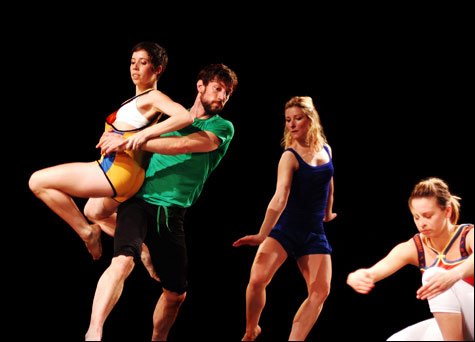
ROCK. PAPER. FLOCK. Pretending to make a dance on the spot. |
Chris Elam's dancers don't resemble the sleek prodigies currently vaulting across our stages. Not that they lack dance training, but they don't have that groomed, purebred look. They're more like characters, individuals, who've arrived to dismantle their physical suppositions in front of an audience, whatever the cost to their vanity. Elam's Misnomer Dance Theater performed three seriously zany works Thursday night under the title "Being Together," in their third appearance for Concord Academy Summer Stages Dance.
The evening began with Too Late Tulip, in which two contrasting ideas about not looking elegant faced off and eventually came to a tentative agreement. Three women in clingy shifts — Jenny Campbell, Jennifer Harmer, and Coco Karol — started with the deportment of ballet dancers and proceeded to jut and twist and squiggle everything that should have been straight.
To a slow klezmer tune, Val Loukianovets and Brynne Billingsley began a duet that evolved from a suggestion of a waltz to spine-sprung grapplings and head-to-head scramblings on the floor. The three exotics or nymphs watched them with curiosity and disdain. Karol got Loukianovets's attention for a few minutes, but he didn't seem to know what to do with her and she backed away. He summoned Billingsley to return, standing on one foot and beating on his own shoulder. She seemed reluctant to forgive him.
Elam doesn't mind if the audience has differing interpretations of his work. As this drama ended, to a reprise of the initial song by a countryman who celebrates domestic life, the four women sat down in a row and Loukianovets gazed at one after the other. It could have been a rustic ménage à cinq — or a deconstructed Afternoon of a Faun.
In Rock. Paper. Flock., the company pretended to be making a dance on the spot. Tall and lean and slightly awkward, Elam plays a choreographer who gives the dancers instructions that they're supposed to carry out in their own way. Some of the instructions are unfathomable ("Coco, do what I'm thinking"), but the dancers get right to work. He appraises them with feigned expertise, and after a long, seemingly improvised interlude of tangles and intertwinings, he commands them to remember exactly what they've done.
At some point he hands Jennifer Harmer his thinking cap, a talismanic 1920s aviator's helmet and goggles, and tells her to take over while he looks at the dance from the audience. He's annoyed when she doesn't want to give it back. The dancers obey their leader without question. They've learned to depend on one another and not to look surprised, no matter what happens.
In Zipper, they often work in pairs, knotting together and then wandering off on their own. The dance has a commissioned score by Evan Zipporyn recorded by the Real Quiet ensemble. We hear short phrases on a cello and piano, nothing like an extended melody, and later soft thumps and clicks and clangs of percussion. The dancers seem to be following this accompaniment with episodic phrases of their own. Like the music, the dance feels interrupted but consistent over a long time.